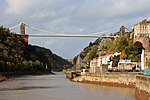Hotwells railway station

Hotwells railway station, was a railway station situated in the suburb of Hotwells in Bristol, England. It was the original southern terminus of the Bristol Port Railway and Pier which ran to a station and pier at Avonmouth. The station opened in 1865, originally named Clifton station, and was situated in the Avon Gorge almost underneath the Clifton Suspension Bridge, near the Clifton Rocks Railway, the Hotwells terminus of Bristol Tramways, the Rownham ferry and landing stages used by passenger steamers. In 1871 the railway company was acquired by the Great Western Railway who created a tunnel under Clifton Down and linked the Port and Pier line to Bristol Temple Meads railway station. This left the Hotwells branch as a stub. The station remained open, renamed as Hotwells until 1921 when it and the track to Sneyd Park were removed to enable the building of the Portway road.The only trace remaining today is a short tunnel under Bridge Valley Road which was used during the Second World War as an air raid shelter. Overcrowding became such a problem that Bristol City Council had to institute a permit system. In later years, until 1996 part of the tunnel was used by a local gun club as a short range.
Excerpt from the Wikipedia article Hotwells railway station (License: CC BY-SA 3.0, Authors, Images).Hotwells railway station
Hotwell Road, Bristol Hotwells
Geographical coordinates (GPS) Address External links Nearby Places Show on map
Geographical coordinates (GPS)
| Latitude | Longitude |
|---|---|
| N 51.455854 ° | E -2.627204 ° |
Address
Hotwells
Hotwell Road
BS8 4DU Bristol, Hotwells
England, United Kingdom
Open on Google Maps







